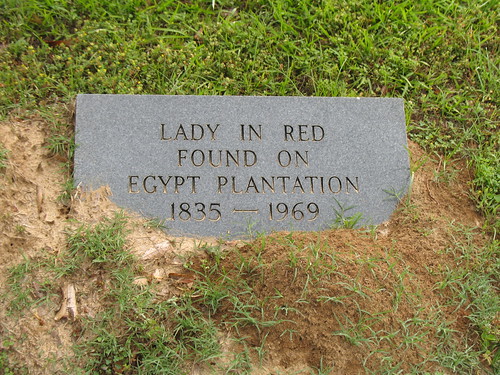In 1969, workers were digging in an effort to install a septic tank in a garden at Egypt Plantation near Cruger, Mississippi. Suddenly they hit something solid. Upon unearthing the hard mass, they discovered a cast iron casket. Cast iron caskets appeared in the first half of the nineteenth century and were a unique commodity. Within the casket lay a woman long dead, though completely preserved, from her auburn hair to her red velvet brocade dress, gloves, and slippers.
Given the cast iron casket, the fashion of her dress, and the mode of embalmment, experts were able to deduce that The Lady in Red died some time in the mid-1830's. How was she so amazingly well-preserved after having been dead over a hundred years? The answer lies in the following newspaper account of the incident:
(Jackson, MS) Clarion-Ledger, 29 August 1969:
"The method of preservation used for the Lady In Red was common prior to the Civil War, when custom-made caskets, shaped to the body, were ordered as one would order a dress.
"The glass that sealed the coffin was placed over the body, and alcohol was poured inside until it was level full, and then sealed with a castiron tip.
"When the back hoe machine hit the coffin, alcohol spilled from the casket and spots of the liquid were seen on the folds of the woman's dress."
Caskets such as the one in which The Lady in Red was found were very expensive. It is assumed that the casket was custom made to fit her petite size. She was obviously a woman from an elite background. Buried only three feet under the earth, it can be supposed that the burial was either unintentional or done in haste. So how did the lady in red come to be there?
Several hypotheses exist. Perhaps she was a member of the Ricks family, the owners of the plantation? However, at the time of her death, Egypt Plantation was run by absentee owners. The owner's family did not reside on the property, and the garden was not located on a site that used to be a cemetery. Therefore, it is highly unlikely that she was at all related to the owner of the plantation. Could she have died of yellow fever while traveling via steamboat, necessitating her immediate burial? Given the elaborate coffin and embalming technique employed, I feel this is highly unlikely. My best guest, which can only be a guess given the mysterious nature of this story, is that The Lady in Red died somewhere far from home. She was placed in cast iron and preserved in alcohol to facilitate her transport to her burial site. Something went amiss during her lugubrious journey, and she either fell out of the riverboat or was mistakenly unloaded. Those are my thoughts. I could be quite far from the truth.
Who was The Lady in Red? We will never know. She lies in her final resting place, the pauper's side of Odd Fellows Cemetery in Lexington, Mississippi.
Photo copyright Natalie Maynor.


such a great mystery. Thanks!
ReplyDeleteI have my own theory.
ReplyDeleteThe description of the coffin as having been "form-fitting" suggests that it was a "Fisk metallic burial case." These coffins were patented in 1848 and mass-produced (in Long Island, NY) for sale to the public between 1849 and the mid-1850s. Such a coffin wasn't custom-made at all, but rather, was probably one of several standard sizes offered. It had an appearance of an Egyptian sarcophagus, constructed of cast iron with a glass viewing window over the body's face. The purpose of the coffin was to hermetically seal the body (immersed in preserving fluids, such as alcohol, brine, etc.) for transporting it long distances for burial, as this was in the days before embalming was commonly practiced. Fisk coffins sold for up to $50...a lot of money at that time (about $1500 today), but nonetheless equivalent to the price of a modern casket purchased from a funeral home.
I propose that the woman had either died in a town (possibly Greenwood) upriver from Egypt Plantation, or had died a long distance away and was sealed in a Fisk coffin and shipped by steamboat to Greenwood, and then was buried in a town cemetery. The woman probably died in the early 1850s, perhaps from the yellow fever epidemic that hit the region in 1853. The coffin was only partially filled with alcohol (resulting in the later description of "spots of alcohol in her dress folds" when she was unearthed), which left a significant amount of empty space inside the coffin...enough space to render it buoyant when placed in water. During one of many subsequent floods that inundated Greenwood (including local cemeteries), the coffin floated out of its grave and drifted to the nearby Yazoo River. Once in the river channel, it drifted 15 miles downriver along countless meanders along the way. By pure chance, the river current floated the coffin out of the channel at Egypt Plantation and deposited it alongside the river, settling it in the mud and covering it over with sediments. Subsequent floods added a full 3 feet of sediments on top of it, leading to the erroneous belief by its discoverers that it was deliberately buried there by mourners. Research of Greenwood burials in the early 1850s (including yellow fever victims) might produce some possible identities of the woman.
Just my theory.
http://genealogytrails.com/scar/fisk_coffins.htm
I think that is a very plausible theory.
DeleteWhat was her race?
ReplyDelete